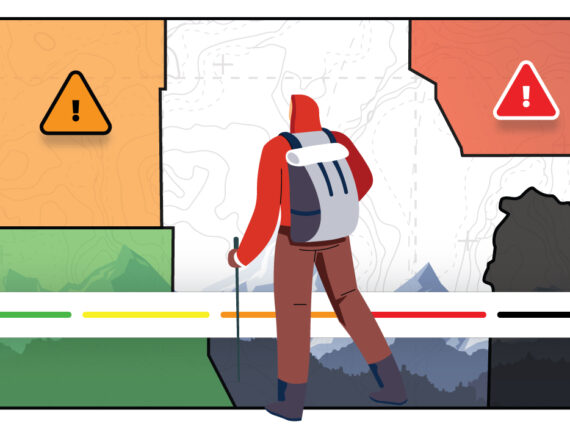It’s been said that web design, as an industry, has been inching towards what Chris Kiess refers to as the “The McDonaldization of UX” or oversimplification of the UX design process. The question then becomes this: When there is significant emphasis on utilizing best practices, getting design done as quickly as possible, and achieving the efficiencies that a fast food restaurant brings, is it possible to bring creativity and innovation to your design? Can the designer and client both reap the benefits that standardization brings, and avoid the pitfalls of genericizing?
Why user research matters
Recently I worked with New Hampshire Department of Heath and Human Services (NHDHHS) on a new public-facing website for The Doorway program, which was launched in response to the state’s opioid epidemic. The site was designed and implemented under aggressive timeline constraints, but one of the things we prioritized with NHDHHS was the use of research to validate decisions relating to content and user experience.
Under such tight timeline constraints, GovWebworks and NHDHHS might have decided to skip the user research and design iteration steps to speed up delivery to the greatest extent possible. But if we’d done so, we would have left needs unmet, and would have failed to reduce a significant barrier some individuals had to receiving treatment for their opioid use.
One primary goal of The Doorway’s site is to provide details about the locations where NH citizens struggling with substance use can be evaluated, speak to providers about treatment, and be referred for treatment. Initial designs of the location detail pages made assumptions about the importance of location-related content. But when we conducted the user surveys, which engaged members of provider communities and individuals who’d sought services in the past, they brought to light a particular need that might have been missed.
In the surveys, the primary audience for the tool expressed desire for access to information about funding, and about how an individual can pay for services or find services available for low or no cost. User research helped us uncover this unmet need – until now, informational resources about these services in New Hampshire lacked a critical piece of information, meaning some individuals seeking treatment may have abandoned the process before actually receiving help. Understanding this gap allowed us to make a more informed decision about the site’s content and user experience in order to increase its effectiveness and reach.
Standards, not stagnation
McDonaldization is a term that initially appeared in the 1993 book The McDonaldization of Society by George Ritzer. It describes the phenomenon of the real world taking on certain characteristics – such as efficiency, predictability, and control – of fast food restaurants. McDonaldization can also bring about negative characteristics such as oversimplification and deskilling, which causes a workforce to emerge that is minimally skilled, and is equipped to conduct only simple, specific tasks.
Kiess takes it a step forward, describing the McDonaldization of UX as the process of streamlining the user experience design processes to the point that business analysis, user research, and creative exploration is sidelined in favor of relying solely on established best practices. This is troubling for a field like user experience design which in its best form combines quantitative data with softer, harder-to-measure aspects of human behavior and experience.
Don’t get me wrong, I don’t believe standardization needs to equate to stagnation. Standards play an important role in UX design. Nielsen’s Heuristics are 10 principles for interaction design that guide designers to follow certain rules such as providing visibility of system status to match the system to the real world. Their goal is to minimize reliance on a user’s memory to complete functions. They apply to almost all interaction designs globally, regardless of who the audience is or what the application is intending to do. Designs that reflect Nielsen’s Heuristics are on a solid path towards providing interfaces that are effective, clear, and functional. You, as a designer, may follow other best practices as well. For instance, there’s the rule of thumb that a selection of options available to your user should be presented with radio buttons when the list has fewer than six options, and as a dropdown when the list has greater than six option, and other such guidelines.
More than heuristics
However, my point here is that heuristics and standards will only get you halfway there. We may miss the mark if we do not provide room to think creatively, analyze the needs and use cases, and try out designs that may initially fall short (but in the process of ‘failing’, they shed light on the users’ behaviors and needs through testing or research). Heuristics and standards alone will create adequate – but not excellent – interactions that may fail to innovate, fail to wow the user. The grander-scale effect of this falling short is that our collective knowledge about how best to meet user needs may in fact stagnate.
As demonstrated by the NHDHHS case study discussed above, organizations and designers alike would do well to value the roles that business analysis and research play in the creative process. They bring forth a greater understanding, not only of general guidelines for good design, but of a given product’s specific guidelines for good design, based on the product’s users. Designers may need to take it upon themselves to enhance their own business analysis capabilities and advocate for budget and time to be spent on user research and other creative exploration. Most of all, designers should work within their organization to ensure business analysis is a part of the discovery and design processes.
In summary
A final message to organizations and designers – go ahead and aim for standardization, because there is plenty of value there. But don’t be lulled into a sense of confidence that best practices are good enough, or that the ROI on user research isn’t there. Leaning too heavily on standardization and not enough on business analysis is what creates McUX, which won’t be as informed and won’t meet the user need nearly as well as real UX.
Learn more
- Unconventional Techniques for Better Insights from Satisfaction Surveys, thoughts on collecting subjective and objective data from the new “UX Strategy with Jared Spool” newsletter
- Making more informed design judgements, on “how immediate judgement leads to short-sightedness in the world of design,” by Tanner Christensen from his blog
- Wireframes are More than Greeking Text and Gray Boxes: How a better understanding of wireframes can speed up the website design process, by Hellen Fitzpatrick, GovWebworks
- Contact us with any questions about user-centered design
Author bio
Sarah Crossman’s foundation in Agile project management, as well as her attention to detail and cheerful demeanor, have served her well in her work with business analysis and user experience design for states including Idaho, Minnesota, and Vermont. She also wrote “How to Get the Most Out of Scrum Meetings: Why missing Scrum meetings can mean missing a deadline.”







